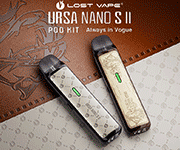K
KulrMeStoopid
Guest
http://onlinelibrary.wiley.com/doi/10.1111/add.12235/abstract
[h=3]Abstract[/h][h=4]Aims[/h]To assess levels of nicotine, nicotine degradation products and some specific impurities in commercial refill liquids for electronic cigarettes.
[h=4]Design and setting[/h]We analyzed 20 models of 10 of the most popular brands of refill liquids, using gas and liquid chromatography.
[h=4]Measurements[/h]We assessed nicotine content, content of the known nicotine degradation products and impurities, and presence of ethylene glycol and diethylene glycol.
[h=4]Findings[/h]The nicotine content in the bottles corresponded closely to the labels on the bottles. The levels of nicotine degradation products represented 0–4.4% of those for nicotine, but for most samples the level was 1–2%. Cis-N-oxide, trans-N-oxide, myosmine, anatabine and anabasine were the most common additional compounds found. Neither ethylene glycol nor diethylene glycol were detected.
[h=4]Conclusion[/h]The nicotine content of electronic cigarette refill bottles is close to what is stated on the label. Impurities are detectable in several brands above the level set for nicotine products in the European Pharmacopoeia, but below the level where they would be likely to cause harm.
The scientific article:
Jean-François ETTER, Eva ZÄTHER and Sofie SVENSSON. “Analysis of refill liquids for electronic cigarettes”. Addiction, 2013, 108: DOI: 10.1111/add.12235
Link to the article: http://onlinelibrary.wiley.com/doi/10.1111/add.12235/pdf
Contact:
Professor Jean-François ETTER, Faculty of Medicine, University of Geneva, IMSP-CMU, 1211 Geneva 4, Switzerland.
Tel +41 22 379 04 59 (office) and +41 76 348 57 86 (mobile).
E-mail: [email protected]
[h=3]Abstract[/h][h=4]Aims[/h]To assess levels of nicotine, nicotine degradation products and some specific impurities in commercial refill liquids for electronic cigarettes.
[h=4]Design and setting[/h]We analyzed 20 models of 10 of the most popular brands of refill liquids, using gas and liquid chromatography.
[h=4]Measurements[/h]We assessed nicotine content, content of the known nicotine degradation products and impurities, and presence of ethylene glycol and diethylene glycol.
[h=4]Findings[/h]The nicotine content in the bottles corresponded closely to the labels on the bottles. The levels of nicotine degradation products represented 0–4.4% of those for nicotine, but for most samples the level was 1–2%. Cis-N-oxide, trans-N-oxide, myosmine, anatabine and anabasine were the most common additional compounds found. Neither ethylene glycol nor diethylene glycol were detected.
[h=4]Conclusion[/h]The nicotine content of electronic cigarette refill bottles is close to what is stated on the label. Impurities are detectable in several brands above the level set for nicotine products in the European Pharmacopoeia, but below the level where they would be likely to cause harm.
The scientific article:
Jean-François ETTER, Eva ZÄTHER and Sofie SVENSSON. “Analysis of refill liquids for electronic cigarettes”. Addiction, 2013, 108: DOI: 10.1111/add.12235
Link to the article: http://onlinelibrary.wiley.com/doi/10.1111/add.12235/pdf
Contact:
Professor Jean-François ETTER, Faculty of Medicine, University of Geneva, IMSP-CMU, 1211 Geneva 4, Switzerland.
Tel +41 22 379 04 59 (office) and +41 76 348 57 86 (mobile).
E-mail: [email protected]












